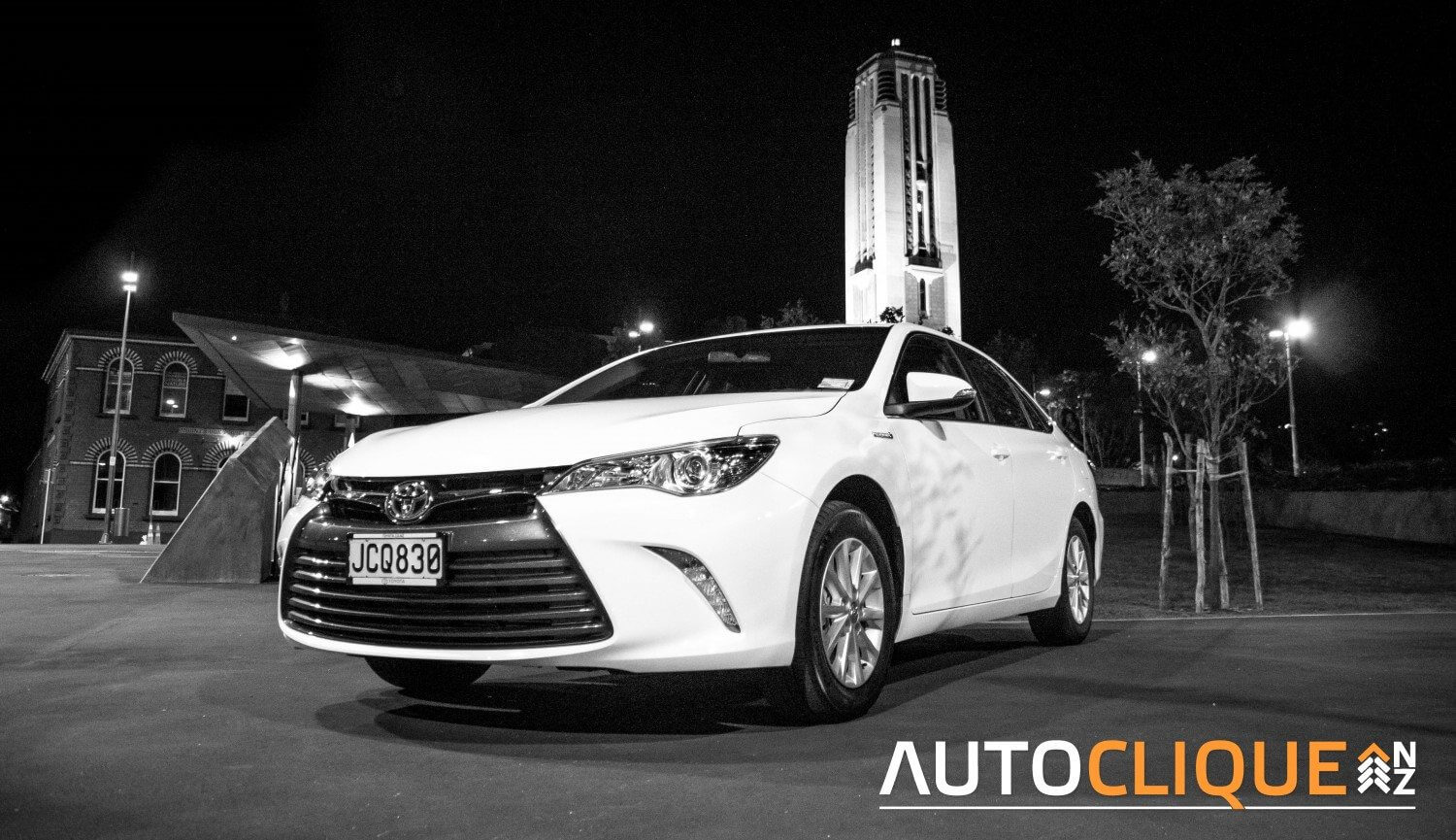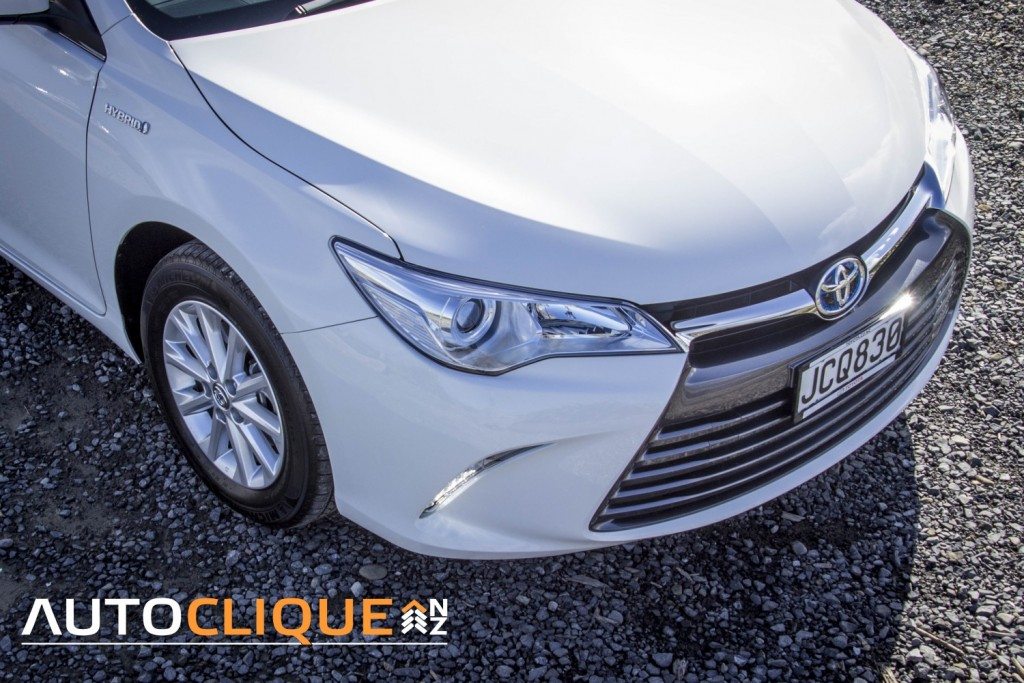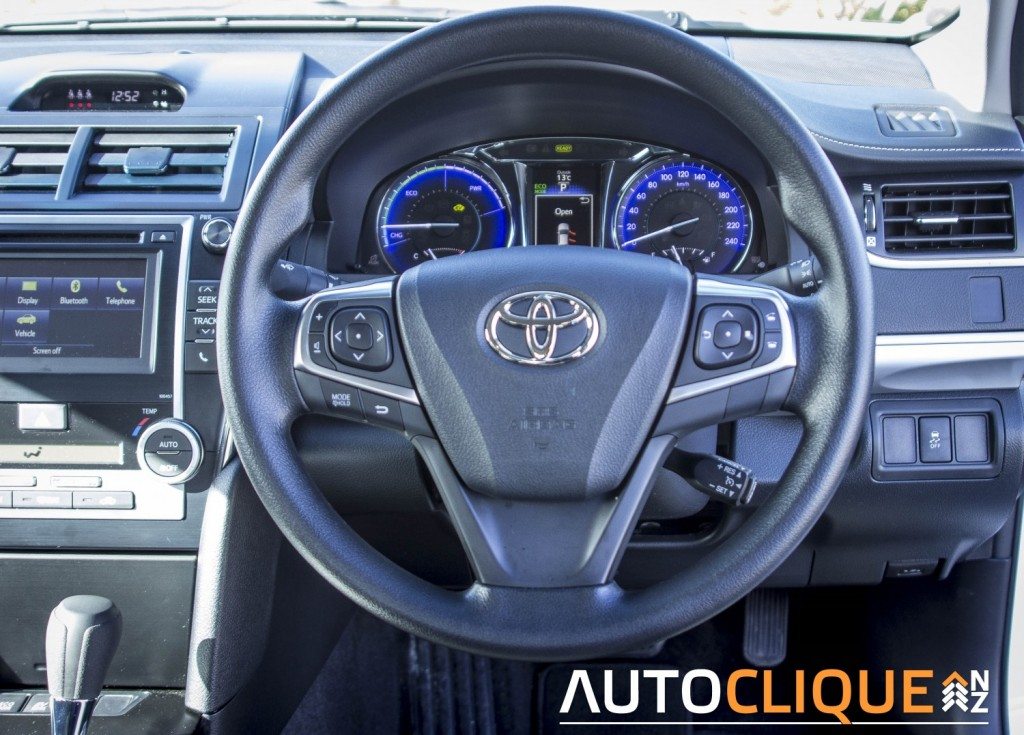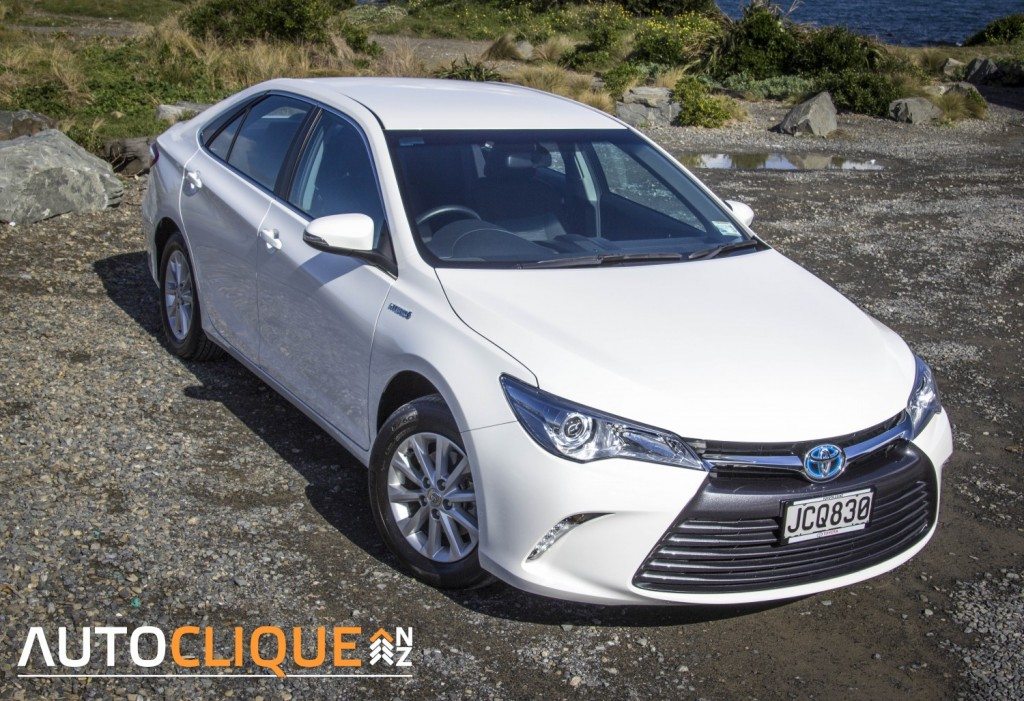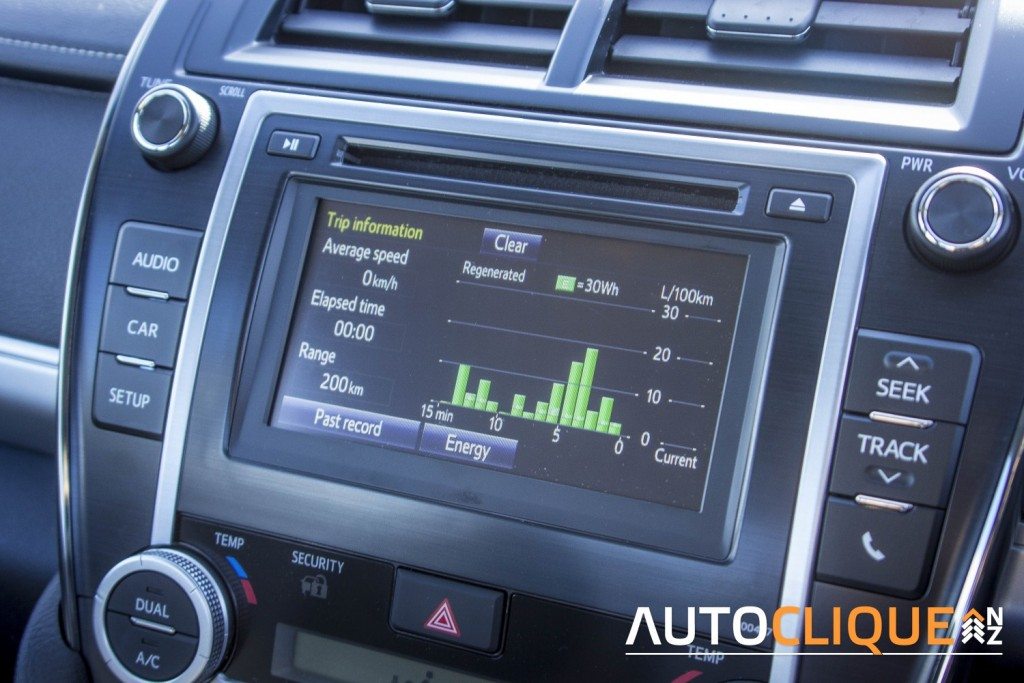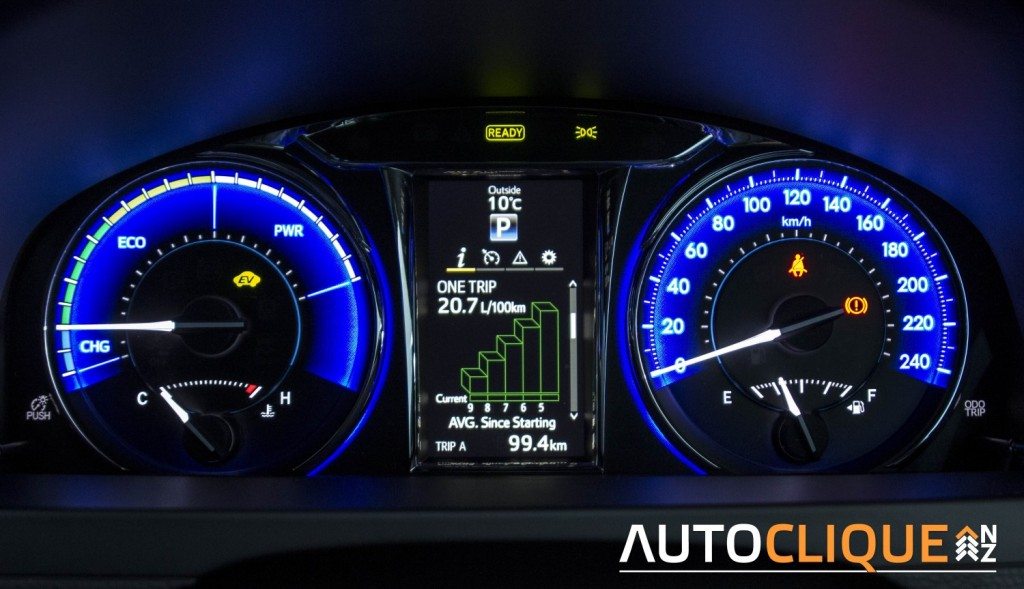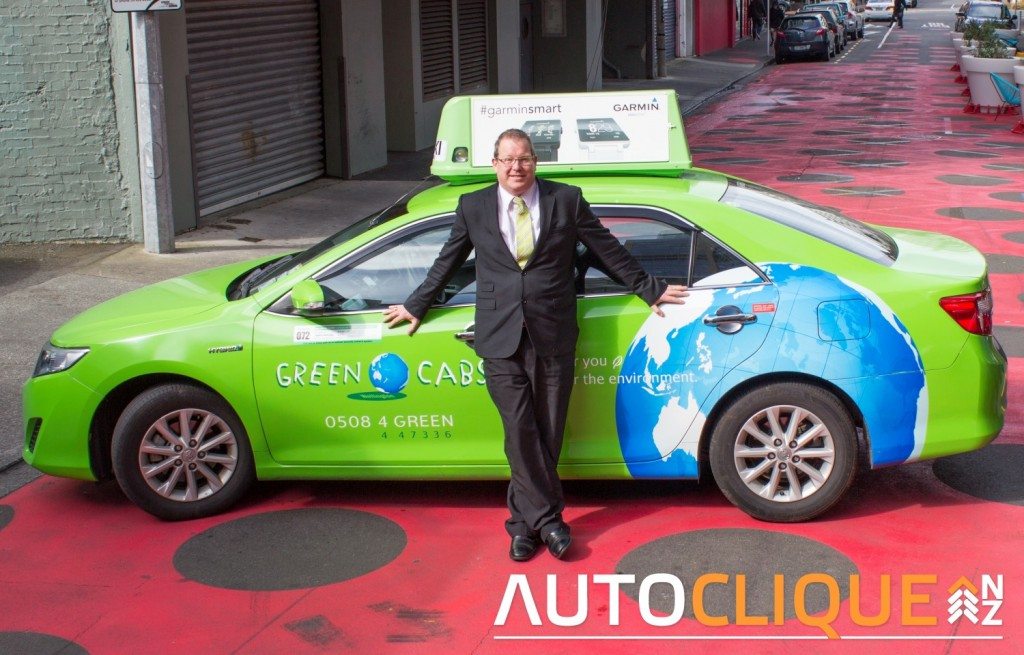All I could think of when going to pick up the test 2015 Toyota Camry Hybrid was, “please don’t be white, please don’t be white.” I had visions of people hailing me from the side of the road, trying to get a ride across town. There’s no avoiding it; the odds of it being white were pretty high. This begs the question: why is it not normally viewed as a family sedan? Why does it seem that nearly all Camry Hybrids you see are taxis?
Poll 1: Hands up if you own a Camry Hybrid and it’s not a taxi?
Poll 2: Who has ever seen a Camry Hybrid that wasn’t white or Kermit green?
Apparently, last year more private buyers opted for Camry Hybrid models than non-hybrids, but I just don’t see this on the street.
Don’t get me wrong. I love technology. I love cars. Put them together and it’s double-love. In fact, I put my hand up when the Hybrid Camry came up for review as I wanted to use it as a daily driver and experience the technology that goes into the car. I dream of cars like this (Ok, maybe not the Camry Hybrid specifically). Tesla, how do I love thee, let me count the amps.
Other than concerns about the colour of this test car, I have a guilty secret of hoping that any test car to be picked up is an up-spec model, and not a base model. Part of that technology thing, perhaps. But this time I was happy the test car was the base GL model. I didn’t want to be blinded by cool gadgets and preferred to see the hybrid as a potential replacement of an average family car, which could be a base model as well. It also meant that the hybrid system needed to stand on its own; not as a differentiator from other manufacturers’ similarly sized models (even though it is) and just as a ‘normal’ car.
There are now 3 models in the Camry Hybrid range: The GL (tested), the Atara S, and the flagship model, the Atara SL. The newly added Camry Hybrid Atara S offers higher grade interior fabric and trim detailing from the GL variant, a powered driver seat with adjustable powered lumbar support and a six-speaker DLX display Audio system. 17” ten-spoke alloy wheels and rear parking sensors are standard specification on the Atara SL. The SL also adds rain sensing wipers, halogen headlamps featuring automatic high beam, an electro-chromatic inside rear vision mirror and reverse tilt outside rear vision mirrors with memory settings, stainless steel scuff plates, wood panel accents and leather trimmed seats and armrest, powered driver and front passenger seats, a powered back window shade and a premium quality JBL ten-speaker audio system with inbuilt navigation. Not enough goodies? The SL model then adds Lane Departure Alert, Blind Spot Detection and Rear Cross Traffic Alert, Dynamic Radar Cruise Control and Toyota’s intelligent Pre-Crash safety system. The SL sounds like a nice place to live!
First Impressions
The 2015 Camry has had a ‘wholesale redesign’ with only the roof carried over from the previous model. Initially I thought it looked quite similar to the outgoing model, but when you compare them side by side it really does like quite different, with a more modern design. The Camry comes with that now-familiar ‘gaping mouth’ look, which is definitely a personal choice. It’s not my choice, but many manufacturers seem to see this as the current favourite styling trend. While I wasn’t prepared to be blown away by the styling of the 2015 model, it does actually look quite nice from some angles (but for me, not the front). Sexy-looking daytime running lights are now standard for 2015 too. Yes, even a white Camry can look good!
However, I do think Toyota may have a bit of a styling battle on their hands; there are some extremely good looking cars in this segment right now (Nissan Altima or Mazda 6, anyone?) and I believe the Camry will struggle in this area. Hybrid it may be, but some buyers (and I’m not talking taxis here) may get seduced by the sexy styling of other cars in this bracket.
The interior of the 2015 model has been updated, and is a nice place to travel in. There is good storage with a fairly large glovebox, lots of cubbys and other storage spots. Plenty of room in the rear too, and a good size boot although it has lost some of the pass-through space that you get in the non-hybrid model, since the battery is located behind the rear seat. The pass-through would get a couple of pairs of skis through but don’t plan on pushing a large bookcase in a box through there.
The 6.1” touchscreen display is nicely clear and easy to use. Without reading the manual it was so simple to pair my iPhone to the car, switch the display to show different readouts about where the car was being powered from and change settings like if/when the doors lock automatically, as well as other settings. Simple but effective. Being a base model there was no navigation, but good options around audio and hybrid information can be found, as well as being the reversing camera display of course.
The single CD audio system was good but not outstanding. For your average punter it does just fine. There did seem to be about a one-second delay when forwarding to another song playing on my phone – I haven’t seen this on other cars. Not a problem but I did start pushing the skip to next track button twice when nothing happened straight away. Certainly not a deal breaker. Good to see a USB charging port in the centre console, thanks Toyota. The buttons for audio volume on the left side of the steering wheel were a bit smaller than I would like. For the 2015 model year, the Camry gets Bluetooth cellphone controls on the steering wheel, with cruise control functions on a stalk on the right side of the steering wheel. The stalk wasn’t in a great location, and shows you how easy it is when cruise control is on the steering wheel. Still, can’t have all the buttons on there.
The ‘Optitron gauge’ lives where the rev counter would normally sit (and is the same size) is certainly one of those devices which makes you use less gas. It became a bit of challenge to try and keep it in ‘eco’ mode, rather than ‘power’. Any braking pushes the dial down into the charge mode, which was always a good feeling, but weirdly I sometimes found myself braking earlier to get that bit more charge going into the batteries.
In between the speedo and Optitron gauge is a 4.2” multi-information display that can be cycled through four modes using the steering wheel controls. I left it on Drive Monitor mode most of the time but the geek in me enjoyed playing around with the other modes.
What’s it like to live with?
It is quite amazing how quickly a hybrid car feels normal. I’m not going to go on just how quiet it is when running on battery only (it is); but moving from the Camry to our daily driver, well it sounded like a diesel. Even with the engine running in the Camry (which is more often that you might think – a slightly heavier touch on the gas and the engine will start) it is still a nicely quiet ride. There is an EV Mode button which forces the car into battery only mode, until you hit just under 50km/h, then it deactivates. My only gripe with the EV button is that it’s in front of the gear selector, like an afterthought. It’s not in a convenient location where you could use it all the time because you really have to reach for it. Line that problem up with the fact that it’s quite hard to keep the car in EV mode (it switches off when you hit about 47km/h) and I ended up ignoring the EV button altogether. A shame.
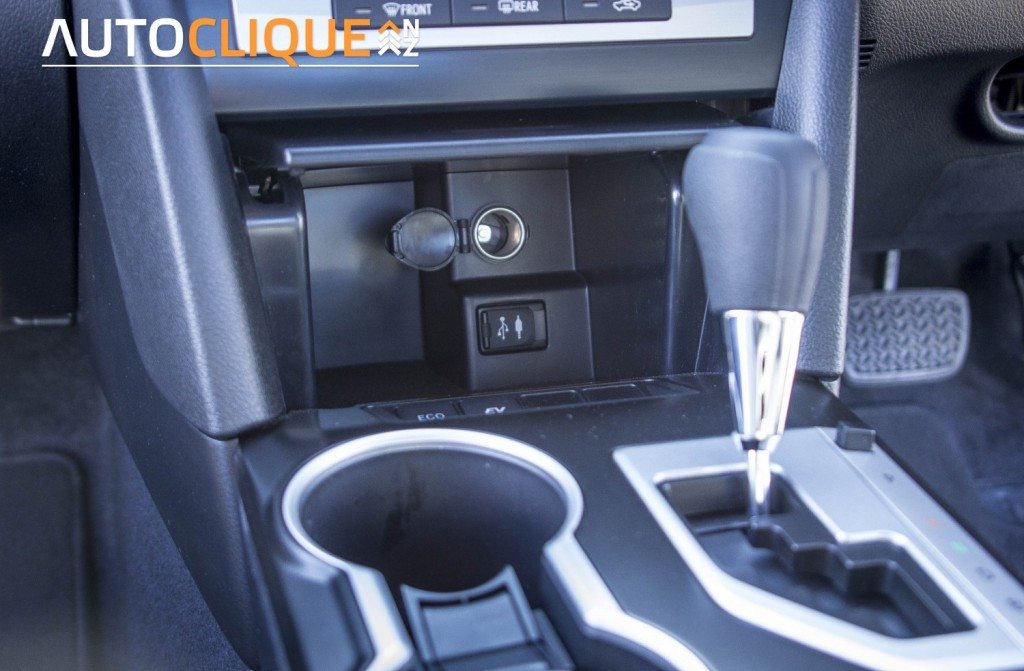
There’s no denying that we’ve had a fair run of Toyotas to test lately. And something that has struck me is just how similar, intended or not, the cars are. Prius, Corolla, Camry. The suspension and steering for example, are so much alike. This isn’t a bad thing. It may be a Camry (and not that king of driving dynamics that is the Mondeo) but the suspension is quiet and nicely firm, yet compliant. Grip is good too – naturally in the wet up a steep hill, hard acceleration will have the wheels lose grip, but overall it’s well controlled. The steering has some good feedback at speed, even though it’s electric. The three models are just so similar it’s quite eerie. I don’t expect the Prado coming up on test to be anything like these three models but I thought it an interesting observation.
One surprise for me was the performance. I’ve driven some Priuses (Prii?) and they can be quite, well, sedate to drive. Not so the Camry Hybrid. Performance off the mark, if you wanted it to be, was a get-up-and-go experience. Fitted with the 2.5 litre engine with now-standard things like VVT-I means that this Camry can really move when it wants to. With a 0-100km/h time of 8.1 seconds, the hybrid is 1.2 seconds quicker to get to 100km/h than the petrol-engined Camry. A combined power rating of 151Kw will do that. The entire weight of the hybrid system looks like it adds only about 100kg to the car, so that’s a great win for Toyota right there. Top speed is down from 210km/h to 180km/h, not that that’s very relevant in New Zealand.
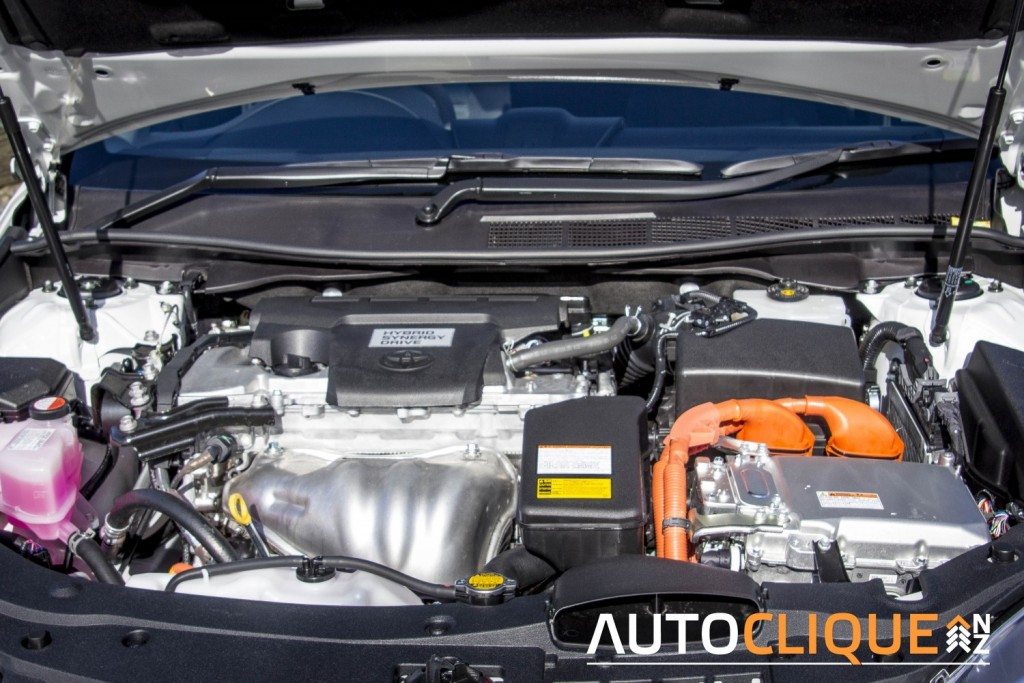
The thing was, this car really forced me to drive sedately and smoothly. I was always conscious of that fuel consumption and felt pangs of guilt whenever the petrol engine kicked in. Fuel economy probably rates highly on the check list of any potential hybrid purchaser. The Camry Hybrid is rated at 5.2l/100km on a combined total, compared to 7.8l/100k for the non-hybrid. I’ll let you decide if that’s worth a $5k premium.
I did use the boot quite a few times during my time with the Camry – it’s pretty much identical of course to the Camry that Rob Clubley tested recently (review to come), except that the pass-through area is way smaller. Still a good-sized boot and plenty big enough for day-to-day duties at 421 litres of space available, although this is down from 515 litres in the non-hybrid.
Safety is well sorted with a suite of seven airbags, including driver and front passenger, driver’s knee, front seat side and curtain airbags. In addition to ABS (Anti-Lock Braking System) and TRC (Traction Control), VSC (Vehicle Stability Control), EBD (Electronic Brake-force Distribution) and BA (Brake Assist) are all standard features.
A woman’s POV
Three things made the Toyota a pleasure to drive, noted by someone who considers a car ‘good’ if it gets me from A to B without breaking down. First, the backing camera. Reversing is not one of my strong suits, so take it from me, the camera was exceptional and perfectly positioned for those of us who, er, have difficulty parallel parking or as another example, reversing out of the driveway without getting dangerously close to the fence. Second thing. The Toyota running on battery was so quiet to drive, I freaked out (in a good way) every time I stopped at a stop sign. I also appreciated its peppiness on taking off from a standstill. The last thing, while superficial, is if you’re like me and often end up being a shopping packhorse for your teenage daughter or just carrying a multitude of grocery bags, being able to pop the boot from the key remote was a big plus.
Only two little niggley things I didn’t like quite as much – the stereo controls on the steering wheel were small and a little fiddly when I was trying to keep my attention where it belonged on the road. I also found the automatic gear shift a little clunky to move when using the gear change thingy. Minor things, and I would happily keep driving the Toyota.
A Taxi Driver’s POV: Rob Wheeler and his 84,000km, 2013 Camry Hybrid
There’s nothing like getting the bottom line from a taxi driver; I decided to talk to Green Cabs driver Rob Wheeler, who owns and drives a Kermit green 2013 Camry Hybrid that has done quite a few kilometres in just two years.
I asked Rob the first and most obvious question: any problems? “No problems, no rattles and not a squeak. The Camry has been 100% reliable,” he said. I was amused when he answered my questions about any comments or questions from passengers. His response? “Most of them ask how often I have to plug it in.” I guess some people struggle with the definition of ‘hybrid’.
“The servicing costs are the same, $199 for a normal service,” Rob added. “Would I buy another? I’d replace it with another one, but really I’m biding my time for a full electric taxi with a decent range.”
With five people on board, Rob says the car is “A bit wallowy in the corners, but fuel economy doesn’t change. I get 5.5L/100km economy with AC on all the time, and my best was 4.8 on a long trip, when the Camry is more economical – the opposite of what people think it would be.”
Any problems he can think of? Like me, he doesn’t like the location of the EV button, but he also mentioned he found the tow capacity of just 300kg (braked or unbraked) a limiting factor (compared to the standard Camry of 500kg unbraked tow capacity).
“Performance is great and that surprises some people,” Rob says. “I believe once the range hits 400kms in a fully electric car, it will be a no brainer. Hybrid will be the only way to go.”
What it’s up against
| Brand / Model | Engine | Power | Fuel L/100km (combined) | 0-100km/h | Price Highest to Lowest |
| Toyota Camry Hybrid | 2.5L VVT Hybrid | 151kw | 5.2 | 8.1s | $50,790 |
| Holden Commodore Evoke | 3.0L VVT V6 | 185kw | 8.3 | 8.8s | $49,990 |
| Mazda 6 | 2.5L VVT | 138Kw | 6.6 | 8.2s | $46,645 |
| Hyundai Sonata | 2.4L VVT | 138Kw | 8.3 | 8.9s | $45,990 |
| Nissan Altima | 2.5L VVT | 127Kw | 7.5 | 9.2s | $43,990 |
| Kia Optima | 2.4L VVT | 148Kw | 7.9 | 8.7s | $43,990 |
| Ford Mondeo Ambiente (hatchback) | 2.0L VVT turbo | 149Kw | 8.2 | 7.9s | $43,990 |
S and SL pricing
Toyota Camry Hybrid Atara S FWD 2.5P Petrol/Electric Sedan/4 ECVT $51,690.00
Toyota Camry Hybrid Atara SL FWD 2.5P Petrol/Electric Sedan/4 ECVT $58,290.00
The Good and the Bad
| Pros | Cons |
|
|
What do we think?
Does having a hybrid car make you more conscious of your fuel consumption, and make you want to drive slower and more smoothly? For me, yes. Is that bad? I think when you are talking about a Camry Hybrid as your daily driver, then it’s got to be a good thing.
Can it be a normal family car regardless of its drivetrain? Absolutely. After a while it is really just like driving the normal Camry, but with more power and less fuel consumption. But…$50,790 for the base model. I’m struggling with that.
Still, all things considered, the Camry isn’t a sports car and it wasn’t designed to be one. Is it a poor man’s Tesla? No, it isn’t. But we are supposed to rate these cars on their ability to fulfil the market segment they are aimed it. The Camry Hybrid does this perfectly. Totally non-confrontational, easy to drive, economical, peppy, reasonably well equipped for a base model…the list goes on. For that I give it four Chevrons.
Chevron rating
Thanks to Rob Wheeler and Green Cabs for talking to www.drivelife.co.nz
| Vehicle Type | Four-door sedan |
| Starting Price | $50,790 + on-road costs |
| Tested Price | $50,790 NZD |
| Engine | Petrol, 2.5L, 4 cylinder, in-line, 16 valve Double Overhead Cam with Dual Variable Valve Timing-intelligent (VVT-i) and Electronic Fuel Injection, Hybrid technology |
| Transmission | CVT |
| 0 – 100 km/h | 8.1 seconds |
| Kerb Weight | 1575Kg |
| Length x Width x Height | 4850x1825x1470 |
| Cargo Capacity | 421Litres |
| Fuel Tank | 65Litres |
| ANCAP Safety Ratings | 5 Stars |


